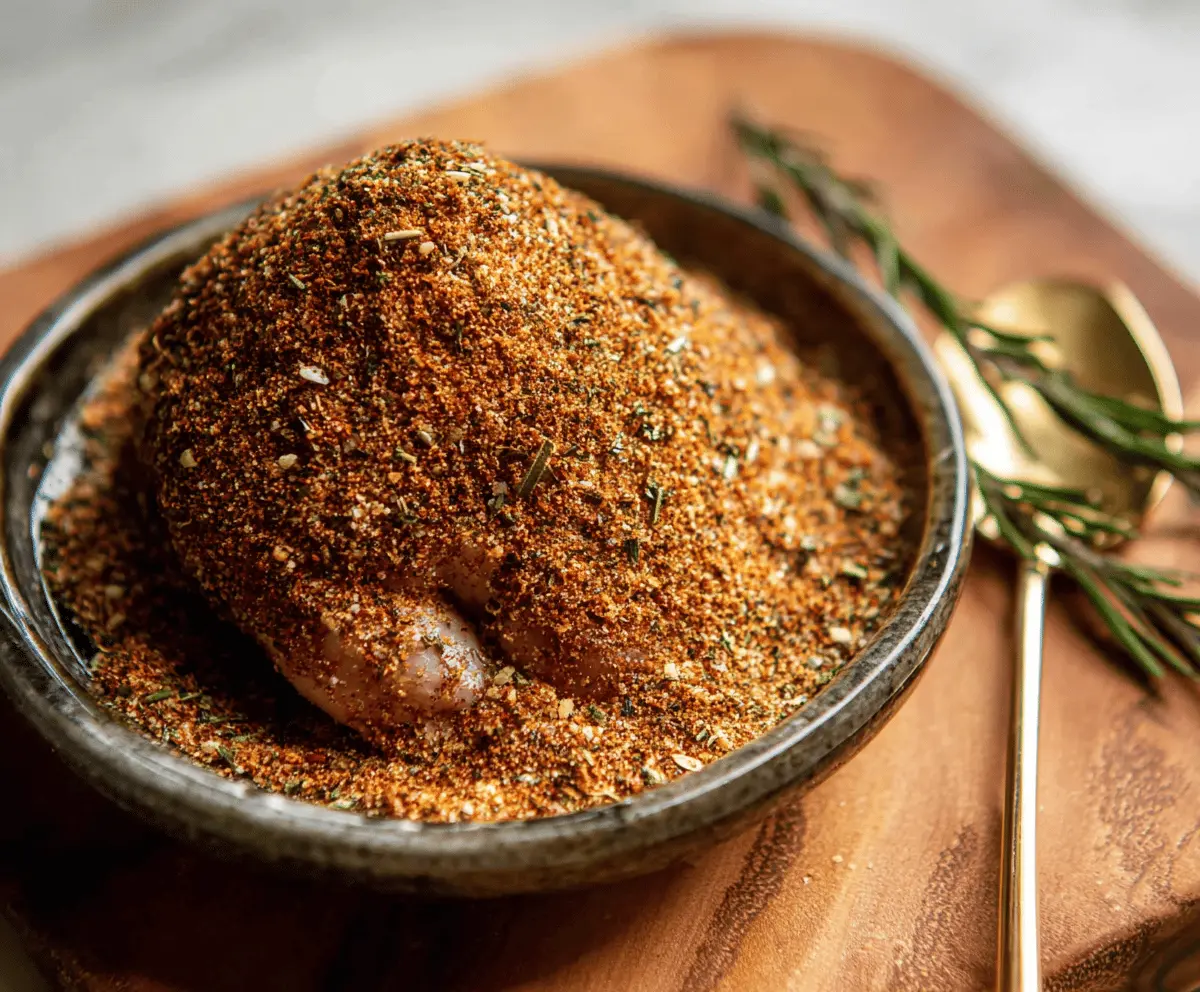This Simple Turkey Rub is just what you need for a tasty turkey! With a mix of spices like garlic, paprika, and thyme, it adds great flavor without any fuss.
Key Ingredients & Substitutions
Paprika: This spice adds color and a mild sweetness to the rub. You can use smoked paprika for a deeper flavor or sweet paprika if you prefer a milder taste.
Garlic Powder: A fantastic flavor enhancer! If you prefer fresh, you can substitute it with minced garlic, but adjust the quantity to about 1-2 cloves.
Kosher Salt: Use this for its coarse texture, which helps in flavoring the meat. If you have table salt, use about half the amount due to its finer grains.
Cayenne Pepper: It’s optional but perfect for adding a little kick! You can leave it out or substitute with a pinch of red pepper flakes for a similar effect.
How Do You Properly Apply a Turkey Rub?
Applying the rub evenly is key for great flavor. Start by ensuring your turkey is very dry; moisture can prevent the seasoning from sticking. Follow these steps:
- Mix the spices in a bowl and then use your hands to rub the mixture onto the turkey.
- Make sure to get under the skin for deeper flavor — gently lift the skin with your fingers.
- Don’t forget the inside of the cavity! This is where a lot of flavor can develop while cooking.
- Let the turkey rest with the rub on it; this helps the flavors soak in. If you have time, letting it sit in the fridge overnight is best!
With these tips, you’re set to make a flavorful turkey that everyone will love!

Simple Turkey Rub
Ingredients You’ll Need:
- 2 tablespoons paprika
- 1 tablespoon garlic powder
- 1 tablespoon onion powder
- 1 tablespoon kosher salt
- 1 tablespoon black pepper
- 1 teaspoon dried thyme
- 1 teaspoon dried rosemary, crushed
- 1/2 teaspoon cayenne pepper (optional for heat)
How Much Time Will You Need?
This simple turkey rub takes about 10 minutes to prepare. Plus, if you let it rest on the turkey for 30 minutes to 1 hour or overnight in the fridge, the flavor will deepen even more. So, overall, you’ll want to plan for some additional time for marinating!
Step-by-Step Instructions:
1. Mix Your Spices:
In a small bowl, combine the paprika, garlic powder, onion powder, kosher salt, black pepper, dried thyme, dried rosemary, and cayenne pepper, if you’d like some heat. Stir everything together well until they are mixed evenly.
2. Prepare the Turkey:
Take your turkey and pat it dry using paper towels. This helps the rub stick and allows for better browning during cooking.
3. Apply the Rub:
Generously rub the spice mixture all over the turkey. Make sure to get under the skin as much as you can and also inside the cavity for maximum flavor. Don’t be shy; really cover the turkey well!
4. Let It Rest:
Once your turkey is seasoned, let it rest for about 30 minutes to 1 hour at room temperature. If you want even tastier results, cover it loosely and refrigerate overnight. This will let the spices soak in, making your turkey even more delicious!
5. Cook Your Turkey:
Now you’re ready to roast or cook your turkey using your favorite method. Follow your preferred cooking instructions until it’s perfectly done.
6. Serve and Enjoy:
Once your turkey is ready, serve it up and enjoy the wonderful flavors from the rub! You’ll have a beautifully seasoned turkey that everyone will love.
Can I Use Fresh Herbs Instead of Dried?
Absolutely! If you prefer fresh herbs, you can substitute dried thyme and rosemary with 1 tablespoon each of the fresh versions. Just chop them finely before mixing into the rub.
Can I Make This Rub in Advance?
Yes, you can definitely prepare this rub ahead of time! Store it in an airtight container in a cool, dry place for up to 6 months. Just give it a good stir before using, as spices can settle over time.
How Should I Store Leftover Rub?
Any leftover rub can be stored in an airtight container. Keep it in a cool, dark place, like a pantry or spice cabinet. It should stay fresh for about 6 months, but for the best flavor, use it sooner!
How Do I Know When the Turkey is Fully Cooked?
The best way to ensure your turkey is cooked through is by using a meat thermometer. Insert it into the thickest part of the thigh without touching the bone; it should read at least 165°F (74°C) for safety. Let it rest for a bit before carving for juicier meat!
